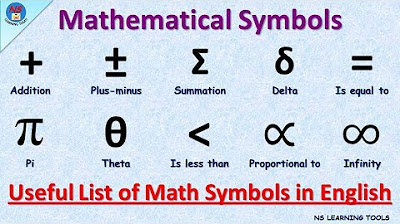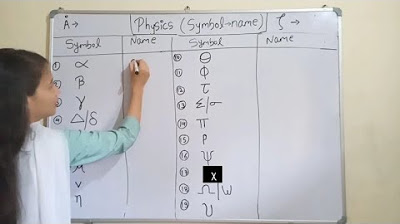Physics के 40 महत्वपूर्ण चिन्ह।। Important Symbol of Physics।। बेसिक Physics
TLDRThe video script is an educational tutorial aimed at demystifying important symbols used in physics. The host, Mohit, introduces various symbols and their meanings in a simple manner to help students, especially those in middle and high school, overcome difficulties in understanding these concepts. The script covers a range of symbols from area, work, resistance, and force to more complex ones like lambda, sigma, and pi. It emphasizes the importance of recognizing these symbols for students progressing to higher classes and encourages viewers to subscribe for more informative content.
Takeaways
- 📘 The video is aimed at teaching important symbols used in physics, which are often problematic for students.
- 🔡 It explains the shorthand method of writing various physical quantities such as area, work, resistance, etc., in a single stroke.
- 📚 The importance of these symbols is emphasized, especially for students in higher classes like 10th, 11th, and 12th.
- 📐 The script covers the representation of area with the symbol 'S' and how to denote it in uppercase for emphasis.
- ⏱ It introduces the concept of time with 't' and differentiates between lowercase 't' for time and uppercase 'T' for a period.
- 🛡 The script explains the symbol for resistance as 'R' and mentions its importance in electrical studies.
- 🎚 The Greek alphabet is introduced with symbols like alpha (α), beta (β), and gamma (γ), which are frequently used in physics.
- 📉 The symbol 'Δ' is explained as representing change or difference, used to denote variations over time or in quantities.
- 🌡 The script touches on the symbol for pressure 'P' and its significance in physics.
- 🔁 The concept of frequency and period is introduced with 'f' for frequency and 'T' for the period, highlighting their roles in wave studies.
- 🌌 The video concludes with a summary of around 40 key points, suggesting that viewers take screenshots for notes and future reference.
Q & A
What is the main topic of the video?
-The main topic of the video is explaining important physics symbols used in educational contexts, particularly for students facing difficulties in understanding them.
Why is understanding these physics symbols important for students?
-Understanding these physics symbols is important for students because they are frequently used in physics problems and concepts, and recognizing them can help in better comprehension and solving of physics-related questions.
What does the symbol 'A' represent in physics?
-In physics, the symbol 'A' represents area, also referred to as 'क्षेत्रफल' in Hindi.
How is 'time' symbolized in physics, and what are its variations?
-Time is symbolized by the letter 't' in lowercase. When written in uppercase, it often represents 'Time Period' or 'आवर्तकाल' in Hindi.
What does the capital letter 'F' signify in physics?
-The capital letter 'F' signifies 'Force' or 'बल' in physics.
What is the significance of the Greek letters alpha (α), beta (β), and gamma (γ) in physics?
-Alpha (α), beta (β), and gamma (γ) are used to represent different types of particles or radiation in physics, such as alpha particles, beta particles, and gamma rays.
What does the Greek letter delta (Δ) symbolize in physics?
-The Greek letter delta (Δ) is used to denote a change or difference in a quantity, such as change in time (Δt) or change in temperature (ΔT).
Explain the use of the symbol 'Ω' in physics.
-The symbol 'Ω' represents 'Ohm,' which is the unit of electrical resistance.
What does the symbol 'G' stand for, and what is its significance?
-The symbol 'G' stands for the universal gravitational constant, which is crucial in calculating gravitational forces between two bodies.
How is 'resistance' denoted in physics symbols, and what is its importance?
-Resistance is denoted by the symbol 'R' and is important in understanding how much an object opposes the flow of electric current.
What does the lowercase Greek letter 'μ' (mu) represent in physics?
-The lowercase Greek letter 'μ' (mu) represents the coefficient of friction or permeability in physics.
Outlines
📚 Physics Symbols and Their Importance
This paragraph introduces the topic of important symbols used in physics, which are often confusing for students. The speaker aims to clarify these symbols, such as area, work, resistance, and time, by explaining their significance and how they are represented in different contexts, including their shorthand notations. The paragraph emphasizes the necessity of understanding these symbols for students, especially those in higher classes like 12th grade.
🔡 Exploring Greek Letters and Physics Symbols
The speaker delves into Greek letters and other symbols frequently used in physics, which are often a source of difficulty for students. The paragraph discusses the use of alpha (α), beta (β), and gamma (γ) in various contexts, as well as the symbol for change or variation (Δ). It also touches on the notation for steps (τ), the lambda (λ) symbol, and the use of 'l' and 'L' for different purposes, such as length and lambda, respectively.
🎓 Advanced Physics Symbols and Their Applications
This paragraph continues the discussion on physics symbols, introducing more complex symbols like sigma (σ), pi (π), and omega (ω), which are used to represent various scientific concepts. The speaker also covers the notation for force (F), frequency, gravitational constant, and energy, providing examples of how these symbols are used in equations and scientific discussions. The paragraph aims to familiarize the audience with the symbols and their applications in advanced physics.
🌟 Universal Constants and Physics Notations
The final paragraph wraps up the discussion by mentioning universal gravitational constant and other significant scientific notations. It emphasizes the importance of understanding these constants and notations for a comprehensive grasp of physics. The speaker encourages students to take screenshots for notes and subscribe to the channel for more educational content, especially for those preparing for their 10th and 12th-grade exams.
Mindmap
Keywords
💡Physics Symbols
💡Area (A)
💡Resistance (R)
💡Force (F)
💡Alpha (α)
💡Delta (Δ)
💡Frequency (ν)
💡Universal Gravitational Constant (G)
💡Time Period (T)
💡Resistance (Ω)
Highlights
Introduction to important symbols in physics for students.
Explanation of symbols that are often confusing for students, like 'submit' and 'saudi'.
Teaching the shortcut method to write various physics symbols in one go.
Importance of understanding these symbols for students in higher classes like 10th, 11th, and 12th.
Clarification of the term 'area' in English and its significance in physics.
Differentiation between uppercase and lowercase symbols and their meanings.
Use of symbols for mass, time, and resistance with examples.
Explanation of Greek letters used in physics such as alpha, beta, and gamma.
Introduction to the symbol 'delta' used to represent change in physics.
Discussion on the symbol 'lambda' and its use in physics.
Clarification on the use of 'sigma' to represent summation in physics.
Explanation of the symbol 'pi' and its various uses in mathematics and physics.
Introduction to the concept of 'force' and its representation in physics.
Use of the symbol 'omega' for angular velocity and its importance.
Discussion on the universal gravitational constant and its symbol.
Explanation of the symbol for energy and its significance in physics.
Encouragement for students to take screenshots of the video for notes.
Request for feedback and subscription to the channel for more educational content.
Transcripts
Browse More Related Video

Greek Alphabet Symbols List - College Math, Chemistry, & Physics

Proof Symbols Used in Math

List of Mathematical Symbols in English | Math Symbols Vocabulary | 65 Mathematics Symbols

Strangest Math Symbols | How Many Do You Know?

Top 50 Mathematical Symbols In English and Greek

physics symbol name|| greek letter in physics|| physic symbol|| class 11&12
5.0 / 5 (0 votes)
Thanks for rating: